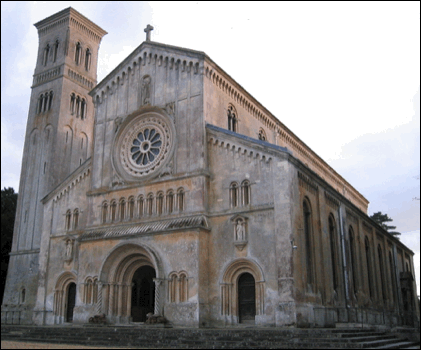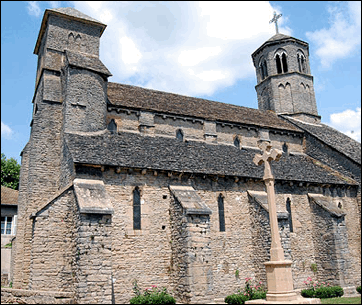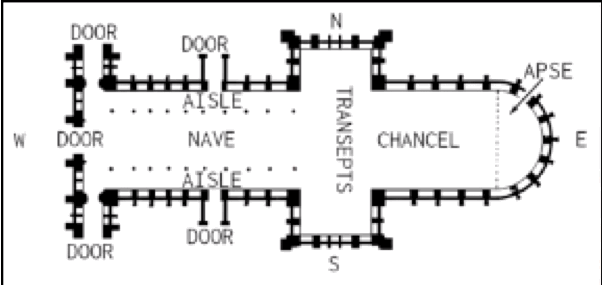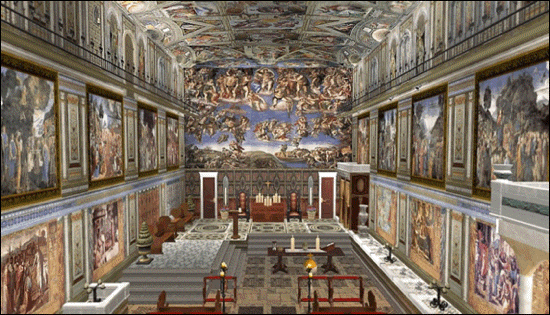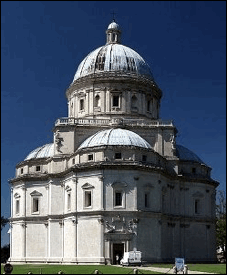Architecture And Worship
Preview
Quote
Note!
Scripture
Question
-
-
-
-
Home Churches
- Home Churches – 1st to 4th Century
-
- Look at page 58 in Eerdman’s and read the caption.
- Congregations met in homes
- A wealthy member might remodel his home (install a baptistry) or add furniture (benches) to accommodate the congregation. Christians who had offered their homes as churches were frequently commemorated by having the churches built on the same site or nearby named after them.
- Sometimes a typical Roman home of an affluent member was fine the way it was. (Jungman, Liturgy)
- A large dining room enabled the common meal
- The atrium, or courtyard at the front of the house, provided a place for the congregation during worship
- The tablinum (a small room off the atrium where Romans kept a shrine to the household gods, lares and penates) provided a place for the clergy to stand while performing the service.
- Did Christians Worship in the Catacombs?
- Hollywood, Not History: Catacombs were found only in Italy (Rome, in particular)
The largest could not hold more than 100 people
“Only burial services, Masses for the dead, and such, could be held there, where a small group, perhaps the relatives alone, would take part.” Jungman, Liturgy, 14-15
- Church at Dura-Europos
- “This church at Dura-Europos is undoubtedly the most significant structure in the history of Christian architecture prior to Constantine. It is the earliest complete church building extant and contains some of the earliest Christian frescoes outside of the Roman catacombs.” Christian History, “Worship”, 33.
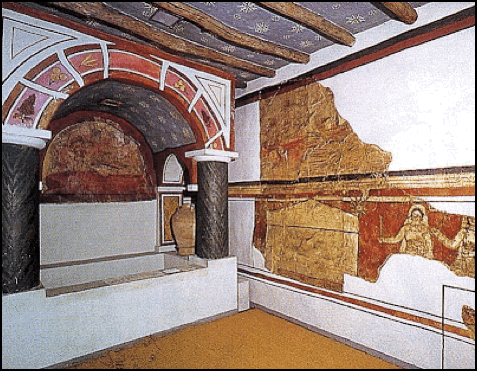
First Church Buildings
- Roman Temples were an unsuitable model
-
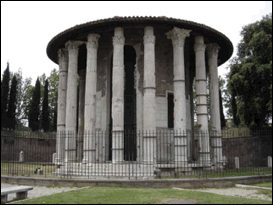
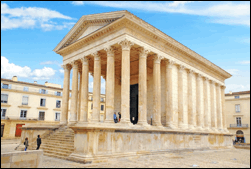
- Connected to pagan gods
- Too Small (Statue, Porch, and Courtyard)
- Designed for Outdoor Worship
- Designed for sacrifices
- The Community In View
- “In pagan antiquity there was no form of worship for which it was essential that a praying community be gathered together. This necessity is to be found only in the religions of revelation…In the Christian religion it is the assembled community, the gathering of the congregation, that is the main thing. Hence the place of worship had to be constructed, as a matter of principle, with the community in view.” Jungman, 16.
- Church Property and Buildings
- Until Diocletian, most persecutions were sporadic and local, more acts of an angry mob than a dedicated persecution. Many congregations played the odds and built churches.
- Legal Rights
- In 272, Paul of Samosota, the Bishop of Antioch, supported the Sabellianist heresy (i.e., modalism - God was one essence AND one person) and was deposed. (He was accused of other things as well.) Paul refused to move out of the parsonage. The church went to court and had him evicted.
- Confiscated Church Property – A Diocletian Inventory
- 2 golden chalices
- 6 silver chalices
- Large number of torches, candelabra and oil lamps
- 6 casks and. 6 earthen vessels (dining room)
- Clothes and shoes (for distribution to the poor)
- 82 ladies’ tunics
- 38 cloaks
- 60 pairs of shoes
- Diocletian’s and the Church at Nicomedea
- The last great persecution of the Church began with Diocletian destroying the church at Nicomedea, a building that just happened to be taller than Diocletian’s palace in Nicomedea. This was one time Christians did not turn the other cheek. In retaliation, Christians burned down Diocletian’s Nicomedean palace. Subsequent events demonstrated Diocletian lacked both a sense of humor and an appreciation for irony.
Basilicas - 4th to 8th Century
- Basilicas
- The first churches for large congregational worship were modeled on government buildings: law courts, business transactions, public meetings and forums. At the end of the 4th century, congregations were meeting in small homes or donated buildings. At the beginning of the 4th Century, the Emperor Constantine constructs St. John’s, the first Basilica Church. St. John’s was longer than a football field. (See Eerdman’s, page 192 for a cross-section view of St. Peter’s Basilica)
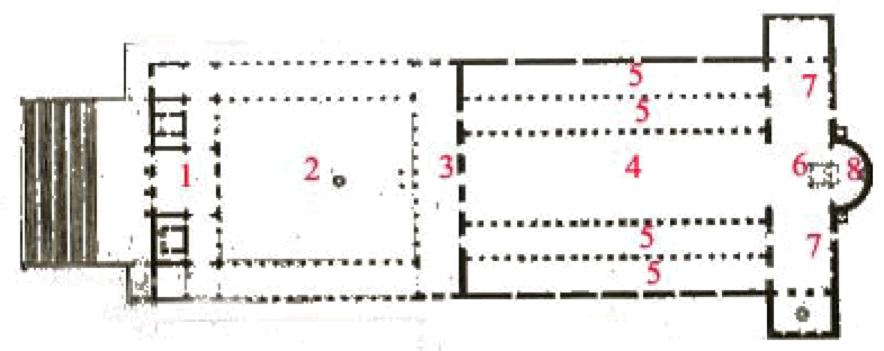
- Early Christianity – The Basilica Church
- Terms to Remember “Romanization of Christianity”
- Atrium (2) - in early Christian, Byzantine, and medieval architecture, the forecourt of a church; as a rule enveloped by four colonnaded porticoes.
- Narthex (3) (Lobby) - the entrance hall or porch proceeding the nave of a church.
- Nave (4) - the great central space in a church. In longitudinal churches, it extends from the entrance to the apse (or only to the crossing if the church has one) and is usually flanked by side aisles.
- Transept (7) - in a cruciform church, the whole arm set at right angles to the nave. (Latin, vertical section is longer; Greek Cross – all sides equal)
- Apse (8) - a recess, sometimes rectangular but usually semicircular, in the wall at the end of a Roman basilica or Christian church. …In the Early Christian basilica, the apses contained the "cathedra" or throne of the bishop, benches for elders, and the altar.
Martyrium
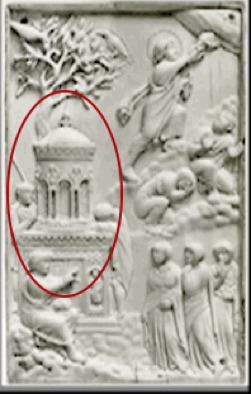
- Martyrium – Circular Churches
- Circular churches were frequently built as shrines to martyrs or tombs for royal/wealthy patrons. The circled area at right is considered to represent the original shrine of the Holy Sepulcher built in Jerusalem by Constantine’s mother, Helena.
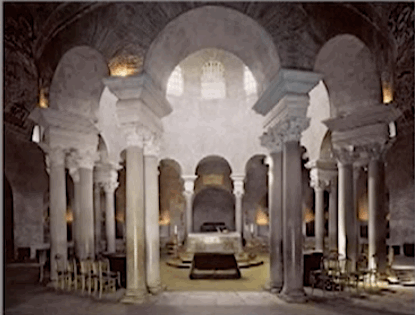
- Tomb of Constantine’s Daughter
- The circular churches frequently had a central domed area supported by columns. The tomb or shrine to the martyr resided in this central section.
-
-
-
-
Mosaics
- Mosiacs
- Early Christian Churches were frequently decorated with mosiacs.
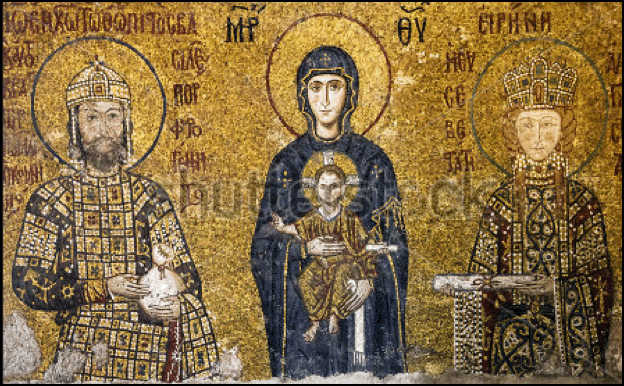
Shrines, Churches Erected In Honor Of ...
- Remember Russ’s Sermon about St. Simeon Stylites?
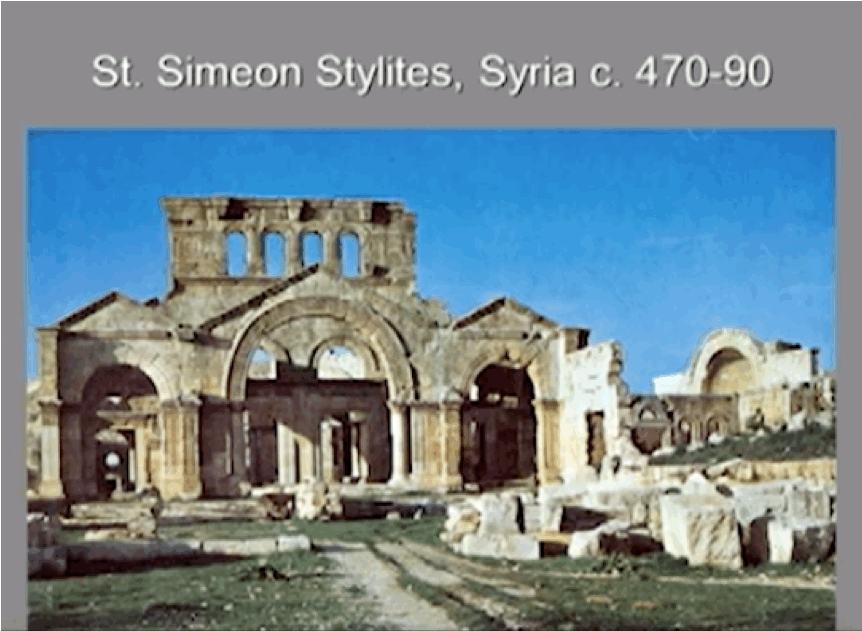 Monasticism Reminder
Monasticism Reminder
- Anchorites - Solitary Desert Monks
- Coenobites – Communal monks�
- Stylites – Pillar monks
-
-
-
-
Cathedrals
- What is a Cathedral? (Eerdman’s, pp 289)
- “A cathedral is merely a church which contains a bishop’s cathedra, or chair...The cathedral itself was developed in size and magnificence far beyond what was needed for its original purpose.”
- Religious Zeal
- Civic Pride – Decorations included all classes of citizens
- Rivalry
- Cathedral Floorplan

- The Cathedral – Civic Purposes
-
- Informal and Formal Social Activity (Meet friends, festivals and feasts, plays performed on the steps)
- Town Meetings
- Trade and Trade Issues
- Labor Exchange
- Shelter for the sick and lodging for pilgrims
Romanesque
- Romanesque – 9th to 12th Centuries
-
- Romanesque Characteristics (Eerdman’s, pp 289-94)
-
- Wooden roofs were a fire hazard, so churches had stone roofs
- Barrel Vaults over nave supported these roofs (See Eerdman’s p 289) and stone buttresses supported the walls
- Thick stone walls meant few and small windows
- Transepts – Sometimes two; Chapels extending from arms of transepts
- Apse - Expanded & surrounded with chapels
- Decorated with tapestries, gilding or jewels on statues, chalices, reliquaries
-
-
Gothic
- Gothic - 12th to 14th Centuries

- Gothic Characteristics
-
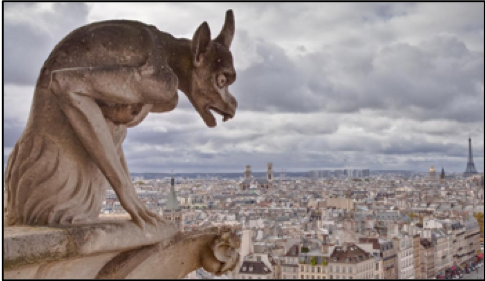
- Floorplan similar to Romanesque
- Flying buttresses meant
- thinner walls
- higher spires carrying eyes and thoughts towards heaven
- More windows = more internal light
- Decorated with paintings, stained glass, rose windows, reliefs, gargoyles - Intended to be Bibles in stone and glass
Stained Glass: The Bible� in Stone and Glass�
- Stained Glass - The Bible for the Illiterate
- “William Durand remarked in the thirteenth century: ‘Pictures and ornaments in churches are the lessons and scripture of the laity.’ Pictures, statues, architecture, poetry, hymns, legends and the theatre were all needed to teach those who could not read.” Eerdman’s p 290
- 4 of the 14 Stations of the Cross
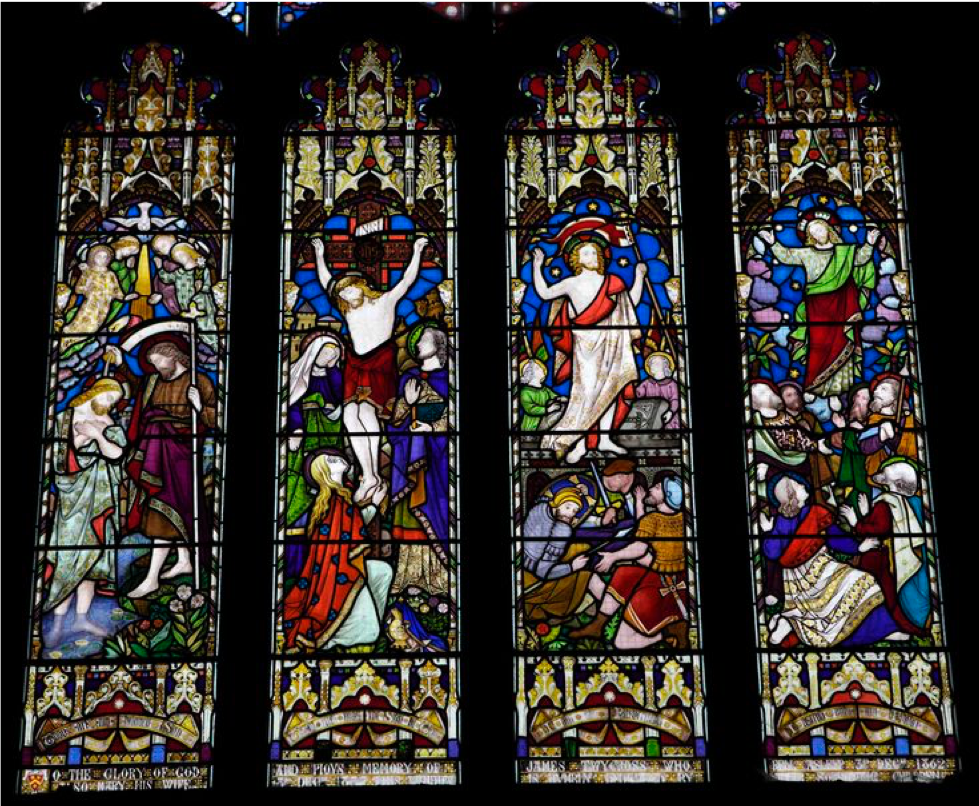
Renaissance - 15th to 16th Centuries
- Renaissance Characteristics
-
- Huge cupolas roofing large inner spaces
- Decorated with paintings, reliefs, free-standing statuary, stained glass
Protestant
- Two Strands
-
- Simple, Strictly Utilitarian Buildings - Protestants, in particular the Puritans, objected to the amount of money spent on beautiful church buildings. In Europe and the new world, they built boxes with steeples in front of them. The pulpit was central, pointing to the preaching of the Word as the focus of worship. Churches that practiced infant baptism might have a font in front of the pulpit; churches that practiced believer Baptism might have a baptismal behind the pulpit. Most Protestant architectural innovations were utilitarian rather than aesthetic.
- CopyCatting - Wealthy Protestant churches built churches on models borrowed from pre-Reformation times.
Baroque -16th to 18th Centuries
- Baroque
-
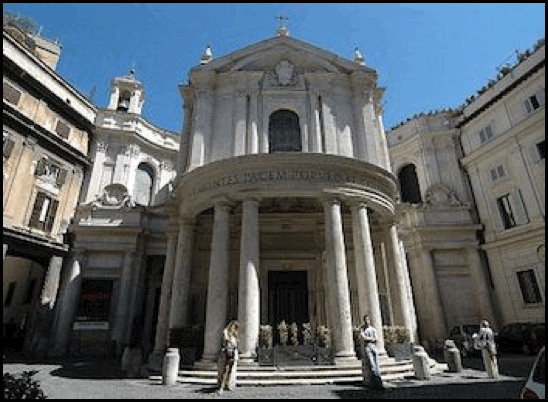

- Baroque Characteristics
-
- Visual Propaganda – Churches meant to strut the power and wealth of the Catholic Church in response to the Protestant Reformation
- Impressive, substantial
- Grand curving walls
- Elongated, distorted architectural elements
- Niches for statuary
- Columned arcades
- Gilt and thin layers of gold
Rococo (Late Baroque)
- Rococo - 18th Century
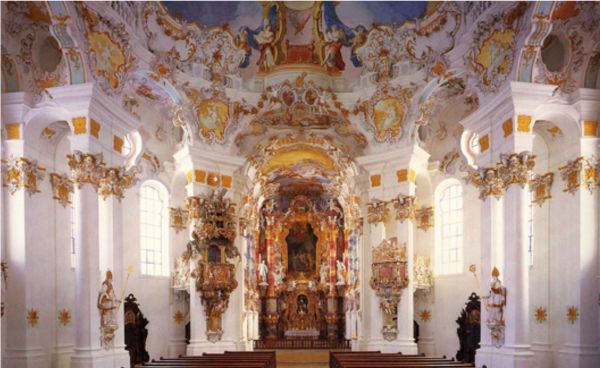
- Rococo (Late Baroque) - 18th Century
-
- As close to psychedelic as you can get without drugs; wildly exaggerated and theatrical on the inside with some churches having a plain, drab exterior
- Ornate, colorful decor, including sculptures and paintings of cherubs
- Vertical axis
Neo-Classical
- Neo-Classical- 19th Century
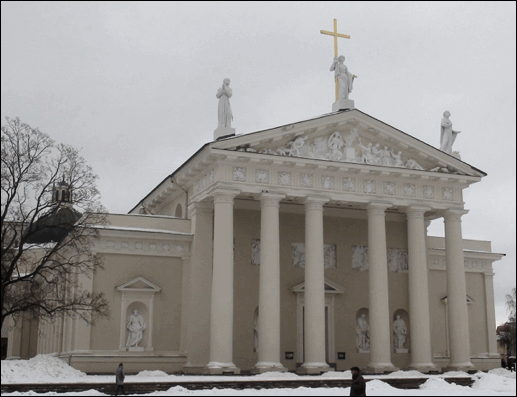
- Neo-Classical – 19th Century
-
- Imitated architectural styles of ancient Greece and Rome, thus look like pagan temples (Lithuanian Church pictured)
- Extensive use of columns
Gothic Revival
- Gothic Revival – 19th Century
- “Interest in Gothic associated with Romantic movement led to attempts to imitate medieval cathedrals”
Walton, Chart 7
-
-
Sources
- Sources
Hull, Dr. Vida. “Early Christian Churches” (YouTube)
- Jungman, S.J., Josef A. The Early Liturgy to the Time of Gregory the Great. London: Darton, Longman & Todd, 1959.
- Przybylek, Stephanie. "Rococo vs. Baroque Architecture.” https://study.com/academy/lesson/rococo-vs-baroque-architecture.html
Sources
- “The Romanization of Christianity and the Christianization of Rome: the Early Christian Basilica”
- The Ten Minute Bible Hour. “The History of Church Architecture in 3 Minutes” (YouTube)
- Walton, Robert C. Church History. Chart 7.







 Monasticism Reminder
Monasticism Reminder
